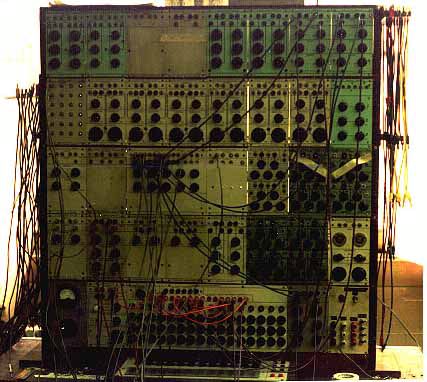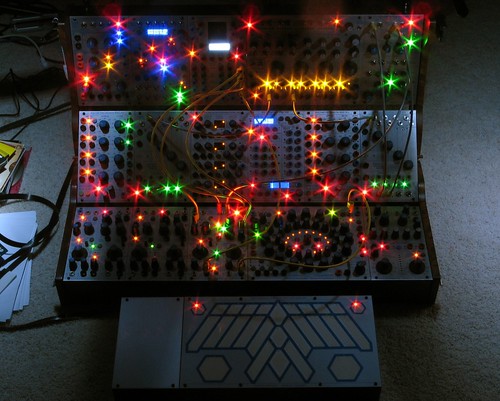But there was more in the air in the early 60s. Don Buchla in California was interested in electronic music and founded Buchla & Associates in Berkeley in 1963. Two synth artists, Ramon Sender and Morton Subotnick at the San Francisco Tape Music Center, commissioned him to come up with a full synth geared to performance. In 1963, Buchla produced the 100 series, the first modular synthesizer which set a standard in synth production. The 100 line was sold to CBS which promptly discontinued it. Then Buchla released the 200 series Electronic Music Box in 1970 and continued to build them until 1985. Buchla synths were keyboardless. One simply turned switches to activate the oscillator to produce a control-voltage signal that one then sent around through various internal circuits. Some models had touch plates to generate signals. Although one would think the Buchla synths would be very difficult to use in performance, they are actually quite easy once one understands how they work. Buchla made his synths for performance.
In 1971, Buchla released the 500 series, the first digitally controlled analog synth. Shortly after this, the company released the Buchla 300 which combined the 200 with microprocessors. The Music Easel was released in 1972, a complete synth that was portable. The Buchla 400 was released in 1982 and then the Buchla 700 in 1987.
Buchla 200 Modular Synth demonstration that shows how just small changes in parameters make a big difference in the sound:
Buchla 200 Modular Synth - YouTube

(Above and below) Buchla 100 series models.


Buchla 200 series Electronic Music box.

The Music Easel.

The Buchla 200e, a 1990s revamp of the old 200 series line. At the bottom are touch-sensitive plates. Buchla reintroduced this souped up model when synthesists bored with purely digital computerized synths with presets (what are called “soft synths”) began to experiment with analogs and expressed the desire to have new analog synths instead of hunting down old, beaten-up analogs. Don Buchla chose to revamp the 200 series because it was his personal favorite Buchla synth.

Buchla 400, which came with a monitor. Note the different type of touch plates.

Suzanne Ciani with her Buchla. Aside from being a recording artist in her own right (she is a classically trained pianist), Ciani’s work is heard in hundreds of commercials, movies, TV shows and electronic games. The old Coke commercial in the 70s where one heard the cap being pried from the bottle and then the coke pouring into a glass fizzing and then the sound of coke bubbles bursting to the jingle of “Things go better with Coke” was the work of Ciani, who is considered the foremost expert on the Buchla. Ironically, she was fired by Don Buchla for whom she once worked at his synth shop on the assembly line for talking which was forbidden but she loves the synths she once built for a living. Her pervasiveness in the field of electronic music and entertainment is enormous. You’ve heard her more times than you can ever count.

The Buchla 700, although less daunting in appearance than the older models, is even more powerful due to the microtechnology that allows for the size and weight reduction.